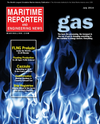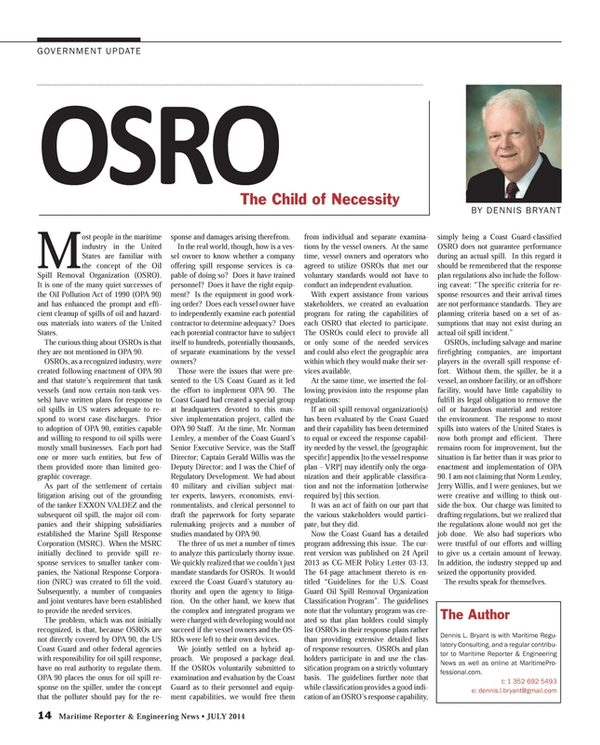
OSRO: The Child of Necessity
Most people in the maritime industry in the United States are familiar with the concept of the Oil Spill Removal Organization (OSRO). It is one of the many quiet successes of the Oil Pollution Act of 1990 (OPA 90) and has enhanced the prompt and efficient cleanup of spills of oil and hazardous materials into waters of the United States.
The curious thing about OSROs is that they are not mentioned in OPA 90.
OSROs, as a recognized industry, were created following enactment of OPA 90 and that statute’s requirement that tank vessels (and now certain non-tank vessels) have written plans for response to oil spills in US waters adequate to respond to worst case discharges. Prior to adoption of OPA 90, entities capable and willing to respond to oil spills were mostly small businesses. Each port had one or more such entities, but few of them provided more than limited geographic coverage.
As part of the settlement of certain litigation arising out of the grounding of the tanker EXXON VALDEZ and the subsequent oil spill, the major oil companies and their shipping subsidiaries established the Marine Spill Response Corporation (MSRC). When the MSRC initially declined to provide spill response services to smaller tanker companies, the National Response Corporation (NRC) was created to fill the void. Subsequently, a number of companies and joint ventures have been established to provide the needed services.
The problem, which was not initially recognized, is that, because OSROs are not directly covered by OPA 90, the US Coast Guard and other federal agencies with responsibility for oil spill response, have no real authority to regulate them. OPA 90 places the onus for oil spill response on the spiller, under the concept that the polluter should pay for the response and damages arising therefrom.
In the real world, though, how is a vessel owner to know whether a company offering spill response services is capable of doing so? Does it have trained personnel? Does it have the right equipment? Is the equipment in good working order? Does each vessel owner have to independently examine each potential contractor to determine adequacy? Does each potential contractor have to subject itself to hundreds, potentially thousands, of separate examinations by the vessel owners?
Those were the issues that were presented to the US Coast Guard as it led the effort to implement OPA 90. The Coast Guard had created a special group at headquarters devoted to this massive implementation project, called the OPA 90 Staff. At the time, Mr. Norman Lemley, a member of the Coast Guard’s Senior Executive Service, was the Staff Director; Captain Gerald Willis was the Deputy Director; and I was the Chief of Regulatory Development. We had about 40 military and civilian subject matter experts, lawyers, economists, environmentalists, and clerical personnel to draft the paperwork for forty separate rulemaking projects and a number of studies mandated by OPA 90.
The three of us met a number of times to analyze this particularly thorny issue. We quickly realized that we couldn’t just mandate standards for OSROs. It would exceed the Coast Guard’s statutory authority and open the agency to litigation. On the other hand, we knew that the complex and integrated program we were charged with developing would not succeed if the vessel owners and the OSROs were left to their own devices.
We jointly settled on a hybrid approach. We proposed a package deal. If the OSROs voluntarily submitted to examination and evaluation by the Coast Guard as to their personnel and equipment capabilities, we would free them from individual and separate examinations by the vessel owners. At the same time, vessel owners and operators who agreed to utilize OSROs that met our voluntary standards would not have to conduct an independent evaluation.
With expert assistance from various stakeholders, we created an evaluation program for rating the capabilities of each OSRO that elected to participate. The OSROs could elect to provide all or only some of the needed services and could also elect the geographic area within which they would make their services available.
At the same time, we inserted the following provision into the response plan regulations:
If an oil spill removal organization(s) has been evaluated by the Coast Guard and their capability has been determined to equal or exceed the response capability needed by the vessel, the [geographic specific] appendix [to the vessel response plan – VRP] may identify only the organization and their applicable classification and not the information [otherwise required by] this section.
It was an act of faith on our part that the various stakeholders would participate, but they did.
Now the Coast Guard has a detailed program addressing this issue. The current version was published on 24 April 2013 as CG-MER Policy Letter 03-13. The 64-page attachment thereto is entitled “Guidelines for the U.S. Coast Guard Oil Spill Removal Organization Classification Program”. The guidelines note that the voluntary program was created so that plan holders could simply list OSROs in their response plans rather than providing extensive detailed lists of response resources. OSROs and plan holders participate in and use the classification program on a strictly voluntary basis. The guidelines further note that while classification provides a good indication of an OSRO’s response capability, simply being a Coast Guard-classified OSRO does not guarantee performance during an actual spill. In this regard it should be remembered that the response plan regulations also include the following caveat: “The specific criteria for response resources and their arrival times are not performance standards. They are planning criteria based on a set of assumptions that may not exist during an actual oil spill incident.”
OSROs, including salvage and marine firefighting companies, are important players in the overall spill response effort. Without them, the spiller, be it a vessel, an onshore facility, or an offshore facility, would have little capability to fulfill its legal obligation to remove the oil or hazardous material and restore the environment. The response to most spills into waters of the United States is now both prompt and efficient. There remains room for improvement, but the situation is far better than it was prior to enactment and implementation of OPA 90. I am not claiming that Norm Lemley, Jerry Willis, and I were geniuses, but we were creative and willing to think outside the box. Our charge was limited to drafting regulations, but we realized that the regulations alone would not get the job done. We also had superiors who were trustful of our efforts and willing to give us a certain amount of leeway. In addition, the industry stepped up and seized the opportunity provided.
The results speak for themselves.
The Author
Dennis L. Bryant is with Maritime Regulatory Consulting, and a regular contributor to Maritime Reporter & Engineering News as well as online at MaritimeProfessional.com.
t: 1 352 692 5493
e: [email protected]
(As published in the July 2014 edition of Maritime Reporter & Engineering News - http://magazines.marinelink.com/Magazines/MaritimeReporter)
Read OSRO: The Child of Necessity in Pdf, Flash or Html5 edition of July 2014 Maritime Reporter
Other stories from July 2014 issue
Content
- Editorial: Gas ... It's Both the Question & the Answer page: 6
- FORAN Users Meeting (FORUM 2014) page: 11
- Harnessing the Wind for Auxiliary Propulsion page: 12
- OSRO: The Child of Necessity page: 14
- Electronic Navigation & Dispute Resolution: Coming of Age page: 16
- The Cause behind the Clause Piers & Docks Insurance page: 18
- AIS Data for Emissions Reduction page: 19
- Turbocharger Modification page: 20
- Interview: Roberto Cazzulo Talks Class Trends page: 22
- Desulfurization of Exhaust Gases in Shipping page: 26
- FLNG Prelude: A New Dawn in the Age of Maritime & Energy page: 30
- Prelude By the Numbers page: 36
- Floating Production: $1.2b Speculative FLNG Ordered page: 38
- Private Equity Drives New Ship Buys page: 40
- Business is Brisk at Posidonia in Athens page: 44
- American P&I Club Rings in Posidonia page: 47
- Unified Emissions Monitoring: Turbulo Bluemon page: 50
- TOTE Ship Receives Powerplant page: 50
- Thrustmaster, DOEN Ink Deal page: 50
- gplink: Remote Monitoring from Finning page: 51
- New Emergency Genset from Cummins page: 51
- Repowered Tug Tows Nonstop page: 51
- FPP Design from Wärtsilä page: 51
- Dynaligner Aims to Eliminate Shaft Misalignment page: 52
- Metal Thickness Gauge Launched page: 52
- New A/C Chiller for Medium to Large Yachts page: 52
- Bernard Offers MIG Gun Customization page: 52
- MEGAFIL Welding Wires page: 53
- Air Hoists Offer Safe & Efficient Lifting page: 53
- CS Unitec Floor Planer Helps Prep for Recoating page: 54
- New Products for Engineroom Ventilation page: 54
- Aluminum MIG Push-Pull Welding Packages page: 54
- Aluminum Oxide Fiber Discs page: 54
- New Cleaning Water Jet Nozzle page: 54
- Dr. Shrink's Extra-Wide Shrink Wrap page: 54
- ABS CErtifies SCIGRIP Adhesives page: 54
- ENC Production Software Launched page: 55
- New Spoolmatic Pro from Miller page: 55
- Bernard’s ‘Best of the Best’ Platform page: 55
- Combat Cold Corrossion via Condition Monitoring page: 56
- Mississippi Hosts Fourth Annual National SeaPerch Challenge page: 57


